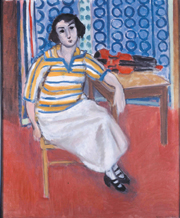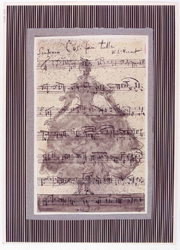 |
||||||
|
||||||
Lost in Art?St. John’s docents help you find your wayby Aloysia C. Hamalainen
It is a miserly time of year. Not enough sun, light or flowers. But a lovely display of generosity is waiting for you at the St. John’s College Mitchell Gallery. The Art of Music from The Baltimore Museum of Art, a gem of an art show, is generous in at least three ways. First, it is the last stop on a statewide tour of a collection that celebrates music and the arts, thanks to the generosity of local and national sponsors. Second, there is no charge, but more than that, you are free to form your own opinion after experiencing more than 45 images and sounds. Third, the best thing about it may not be the art but the invigorating docents who show it to you in a new light. Elizabeth Burlington, a sophomore at St. John’s, dropped in the Mitchell Gallery for her first time last Thursday, the day the docents offer tours. Jack Carr, Marietta Schreiber and Mary Hurd, three of the seasoned art lovers who give these tours, happily ushered her through the two rooms. Carr, an alumnus who has served on the Mitchell Gallery board since it was founded, explained that the purpose of this show is “to show the many themes of music in the arts.” Schreiber, a retired art teacher and watercolorist, explained “there is over a thousand years of music and art here, from a pre-Columbian whistle to a tape of a John Coltrane jazz solo.” The Mitchell Gallery, on the ground floor of the Mellon Building on the St. John’s Street side of the campus, has devoted two rooms to the exhibit. The large, light-filled gallery holds most of the paintings, with glass displays holding the instruments, including antique flutes and an Aboriginal Australian didgeridoo, which sounds like water falling. There is a musical component in every work, but the one big concept that is easy to come away with is that art (or Art) is a timeline, or continuum, of ideas and brainstorms of artists influencing other artists. Art, in that way, is very generous.
For example, an 1866 Japanese wood cut by Toyohara Kunichika of An Actor with a Samisen is adjacent to an 1892 Henri de Toulouse-Luatrec poster Divan Japonais. Schreiber showed Burlington the similarities. Then she asks “Can you see anything in particular happening?” After a bit of careful examination, Burlington noticed the same curved shape repeated throughout the poster, as it represents the three dimensions of music: the stage, orchestra and audience. The docents do not always agree on what a painting means, so your interpretation may be just as valid. Debate on Henri Matisse’s painting Woman in Striped Pullover, Violin on the Table was as sizzling as a pat of butter flicked on a hot pan. “Why is the violin even in the picture?” Schreiber asked Burlington. She replied that the color of the violin mirrored a color on the wallpaper. Speculation flew: It’s a symbol for Matisse himself. No, it’s simply a prop. No, it’s Matisse treating the woman as a still life. No, it’s a contrast to the color scheme. … Burlington was quick to notice examples of a guitar in two works of art that may be as far apart ideologically as they get: A portrait by Jean Baptiste Greuze, an example of a Rococo (mid-18th century) lady, dressed in a frothy, lacey dress, playing a guitar, and a 1950s’ abstraction by Pablo Picasso of a guitar, fractured into its elemental forms, centered on a field of flat colored shapes. Can’t get much more different than that. The second room has more interactive listening stations, with jazz a strong theme. The brilliant color of Romare Bearden’s photo-etching, Jamming at the Savoy, seems to lift the ceiling. “It looks like they can play all night!” Carr says. Another corner is devoted to the incomparable music of jazz saxophonist John Coltrane. A headset with a tape of a Coltrane solo is located under a photograph of him playing and next to an etching of his funeral parade in 1967. You can make your own music on the installation of zinc and magnesium tiles on the middle of the floor. Depending on the soles of your shoes, (leather works best) you can play a little tune by stepping on the tiles, which tinkle like the toy piano you had as a kid. Touring the second room, the docents stop in front of Arthur Carles’ painting of Four Women Listening to the Piano. Burlington is asked to find all the women, which she does, but only after walking backward and looking at the painting from the far left. The fourth woman finally appears, hidden behind the back of the chair. “Looks like my younger sister at family gatherings,” she says. Perhaps the concept furthest from the Mayan whistle is the installation of Marcel Duchamp’s Illusion. You have to close one eye, put on the headphones to listen to a tape of John Cage’s Chance Music and look at a design revolving on a record player to see three-dimensional, moving forms. It does not take much time to experience the exhibit, but the range of the images and sounds are vast, and a docent can tailor the experience to fit you.
The Mitchell Gallery’s docents, like most museum docents, are carefully selected volunteers. The word docent comes from Latin and means to teach, and they do so with enthusiasm and cheerfulness. Their primary criteria are appreciation of the arts, curiosity and eagerness to share their knowledge. Before a new show or exhibit, Carr says the docents “learn from each other” but there may be times they “have to cram a lot.” Hurd, a retired English teacher and a docent for the National Gallery of Art, is an advocate for folks who feel intimidated by art. You don’t have to have a degree in art history, she says, to enjoy looking at masterful paintings and hearing great jazz. Docents are on duty at the Mitchell Gallery Thursdays from noon until 3pm, or by appointment. They are: • Mary Kay Biern: History teacher, Historic Annapolis guide; Mitchell Gallery docent since its inception. • Jack Ladd Carr: St. John’s alumnus who has served on the Mitchell Gallery Board of Directors since its founding. • Lorraine Carren: Director of the Diane Brown Gallery in D.C., docent at the Hirshhorn Museum and Sculpture Garden; Mitchell Gallery docent since its inception. • Carole Falk: Docent at the Smithsonian’s Freer and Sackler Galleries, potter, sculptor and maker of silver jewelry. • Mary Hurd: History teacher, guide for Historic Annapolis for 25 years and Mitchell Gallery docent since its inception. • Judy Nevins: Former chair of Des Moines Symphony Orchestra. • Marietta Meigs Schreiber: Retired art teacher; watercolorist and master gardener. • Joan Vinson: Political consultant to five presidential campaigns, public school teacher, adjunct professor and volunteer. Showing thru April 9 from Noon-5 TuWThSaSu; 7am-8pm F at Mitchell Gallery, in St. John’s College Mellon Hall (St. John’s St. off Calvert St.), Annapolis. Free: 410-626-2539. Aloysia C. Hamalainen, a prize-winning Bay Weekly contributor, is an appraiser of fine art with Rogers Appraisers in Olney. Reach her at 301-570-0779 or [email protected]. |
||||||
|
|
||||||
|
© COPYRIGHT 2004 by New Bay Enterprises, Inc. All rights reserved. |




